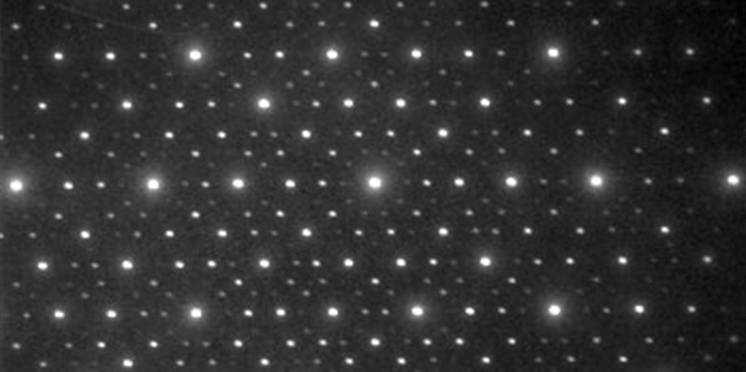wavelength-dispersive X-ray spectroscopy, WDS, WDX
wavelength-dispersive X-ray spectroscopy
A wavelength spectroscopy method for characteristic X-rays emitted from a specimen (WDS). The method measures the wavelength spectra using a wavelength dispersive X-ray spectrometer, and then identifies the constituent elements of the specimen (qualitative analysis) from the spectral wavelength values and determines the concentrations of the identified constituent elements from the spectral intensities (quantitative analysis). WDS can analyze elements ranging from beryllium (Be) to uranium (U).
Comparing to EDS, WDS provides a high energy resolution of about 20 eV, one order of magnitude higher than EDS. Thus, adjacent spectral lines of the characteristic X-ray spectra which cannot be observed separately by EDS can be detected separately for identifying constituent elements. Owing to a high signal-to-noise ratio of the spectrum obtained by WDS, the detection limit of trace elements of WDS is two orders of magnitude higher than that of EDS. That is, WDS can detect trace elements of 100 ppm or less, enabling qualitative analysis of very trace elements (trace light elements of boron (B) to fluorine (F)). WDS provides a high quantitative accuracy, which is compatible to that of wet chemical analysis. The analysis region (volume) is as large as several 100 nm to several µm in both horizontal and depth directions because the incident electrons scatter in the specimen (same as in the case of energy dispersive X-ray spectroscopy: EDS).
Due to its high energy resolution, WDS is suitable for qualitatively analyzing specimens that contain elements whose spectral energies are close, and also for materials containing various rare earths. Especially in qualitative analysis of the rate earths, WDS has a greater advantage than EDS because the L lines of the rare-earth elements are concentrated in a close energy region. That is, EDS cannot qualitatively analyze the constituent elements in those materials, but WDS allows for qualitative analysis (separation of different spectral lines and identification of each constituent element) of them.
However, WDS has the following disadvantages: 1) Compared to EDS, the WDS spectrometer is large-sized and complex-designed. 2) Among characteristic X-rays entering the analyzing crystal, only the X-rays which satisfy Bragg’s diffraction condition are detected by the WDS spectrometer, and thus the detection efficiency of WDS is about one hundredth that of EDS. Therefore, a large probe current of several 100 nA or more is required for acquiring the spectra with a high signal-to-noise ratio. The use of such a large probe current can cause the electron-beam radiation damage to specimens that are susceptible to heat. 3) For analyzing the characteristic X-rays of different elements, the analyzing crystal and the X-ray detector must be mechanically moved along the circumference of the Rowland circle in order to independently detect the characteristic X-rays of each element. The measurements of the X-rays are executed separately for each wavelength, or multiple elements cannot be analyzed simultaneously (unlike EDS). Accordingly, WDS requires a long measurement time. 4) If the analysis region of the specimen surface has an unevenness of around 10 µm, the target analysis point is deviated from the Rowland circle. As a result, the convergence of the characteristic X-rays at the detection point becomes worse and the X-ray intensity detected decreases. To prevent this adverse phenomenon, the specimen surface must be mechanically polished or ion-beam polished to make the specimen surface even.
In quantitative analysis using WDS for a constituent element of interest, a standard specimen is required, whose concentration of this element (Element A) is known.
The first step is to acquire each spectral intensity of characteristic X-rays of Element A in the standard specimen and in an unknown specimen. Here it should be noted that, the conditions to acquire the spectra from the standard and unknown specimens are the same (accelerating voltage, probe current and working distance). The intensity ratio of the characteristic X-rays of Element A in the unknown specimen to those of the standard specimen is calculated. Then, the concentration of Element A in the unknown specimen is obtained by multiplying the concentration value of Element A in the standard specimen to the obtained intensity ratio.
The next step is to apply correction to the obtained concentration of Element A in the unknown specimen for obtaining a high accuracy concentration. That is, the high accuracy concentration of Element A is obtained by multiplying the correction factor calculated by the ZAF method or the φρZ (Phi-Rho-Z) method, where the correction takes account of the differences in 1) the scattering features of the incident electrons and 2) the absorption and fluorescence excitation effects between the standard specimen and the unknown specimen. If there are various elements of interest, standard specimens must be prepared for each element and the steps described above are repeated to obtain the concentrations of each element.
WDS quantitative analysis requires the preparation of standard specimens and takes time and effort for measurement. Thus, to obtain rough concentrations of all of the constituent elements in various specimens, EDS is suitable (WDS is not suitable). The standard-less quantitative analysis using EDS provides satisfactory results. Accordingly, the use of WDS or EDS depends on analytical purposes.
The table below lists the advantages and disadvantages of WDS and EDS.
Table. Comparison of the performance of WDS and EDS
Comparing to EDS, WDS provides a high energy resolution of about 20 eV, one order of magnitude higher than EDS. Thus, adjacent spectral lines of the characteristic X-ray spectra which cannot be observed separately by EDS can be detected separately for identifying constituent elements. Owing to a high signal-to-noise ratio of the spectrum obtained by WDS, the detection limit of trace elements of WDS is two orders of magnitude higher than that of EDS. That is, WDS can detect trace elements of 100 ppm or less, enabling qualitative analysis of very trace elements (trace light elements of boron (B) to fluorine (F)). WDS provides a high quantitative accuracy, which is compatible to that of wet chemical analysis. The analysis region (volume) is as large as several 100 nm to several µm in both horizontal and depth directions because the incident electrons scatter in the specimen (same as in the case of energy dispersive X-ray spectroscopy: EDS).
Due to its high energy resolution, WDS is suitable for qualitatively analyzing specimens that contain elements whose spectral energies are close, and also for materials containing various rare earths. Especially in qualitative analysis of the rate earths, WDS has a greater advantage than EDS because the L lines of the rare-earth elements are concentrated in a close energy region. That is, EDS cannot qualitatively analyze the constituent elements in those materials, but WDS allows for qualitative analysis (separation of different spectral lines and identification of each constituent element) of them.
However, WDS has the following disadvantages: 1) Compared to EDS, the WDS spectrometer is large-sized and complex-designed. 2) Among characteristic X-rays entering the analyzing crystal, only the X-rays which satisfy Bragg’s diffraction condition are detected by the WDS spectrometer, and thus the detection efficiency of WDS is about one hundredth that of EDS. Therefore, a large probe current of several 100 nA or more is required for acquiring the spectra with a high signal-to-noise ratio. The use of such a large probe current can cause the electron-beam radiation damage to specimens that are susceptible to heat. 3) For analyzing the characteristic X-rays of different elements, the analyzing crystal and the X-ray detector must be mechanically moved along the circumference of the Rowland circle in order to independently detect the characteristic X-rays of each element. The measurements of the X-rays are executed separately for each wavelength, or multiple elements cannot be analyzed simultaneously (unlike EDS). Accordingly, WDS requires a long measurement time. 4) If the analysis region of the specimen surface has an unevenness of around 10 µm, the target analysis point is deviated from the Rowland circle. As a result, the convergence of the characteristic X-rays at the detection point becomes worse and the X-ray intensity detected decreases. To prevent this adverse phenomenon, the specimen surface must be mechanically polished or ion-beam polished to make the specimen surface even.
In quantitative analysis using WDS for a constituent element of interest, a standard specimen is required, whose concentration of this element (Element A) is known.
The first step is to acquire each spectral intensity of characteristic X-rays of Element A in the standard specimen and in an unknown specimen. Here it should be noted that, the conditions to acquire the spectra from the standard and unknown specimens are the same (accelerating voltage, probe current and working distance). The intensity ratio of the characteristic X-rays of Element A in the unknown specimen to those of the standard specimen is calculated. Then, the concentration of Element A in the unknown specimen is obtained by multiplying the concentration value of Element A in the standard specimen to the obtained intensity ratio.
The next step is to apply correction to the obtained concentration of Element A in the unknown specimen for obtaining a high accuracy concentration. That is, the high accuracy concentration of Element A is obtained by multiplying the correction factor calculated by the ZAF method or the φρZ (Phi-Rho-Z) method, where the correction takes account of the differences in 1) the scattering features of the incident electrons and 2) the absorption and fluorescence excitation effects between the standard specimen and the unknown specimen. If there are various elements of interest, standard specimens must be prepared for each element and the steps described above are repeated to obtain the concentrations of each element.
WDS quantitative analysis requires the preparation of standard specimens and takes time and effort for measurement. Thus, to obtain rough concentrations of all of the constituent elements in various specimens, EDS is suitable (WDS is not suitable). The standard-less quantitative analysis using EDS provides satisfactory results. Accordingly, the use of WDS or EDS depends on analytical purposes.
The table below lists the advantages and disadvantages of WDS and EDS.
| WDS | EDS | |
|---|---|---|
| Detectable element range | Be to U | Be to U |
| Detection method | Wavelength disperive method with analyzing crystal |
Energy disperive method with semiconductor detector |
| Energy resolution | About 20 eV | About 130 eV |
| Measurement speed | Slow | Fast |
| Simultaneous multiple-element analysis | Not possible | Possible |
| Detection limit | 10 to 100 ppm | 1500 to 2000 ppm |
| Detection X-ray volume per current | Little | Many |
| Specimen damage | Many | Little |
Related Term(s)
Term(s) with "wavelength-dispersive X-ray spectroscopy" in the description
Are you a medical professional or personnel engaged in medical care?
No
Please be reminded that these pages are not intended to provide the general public with information about the products.




